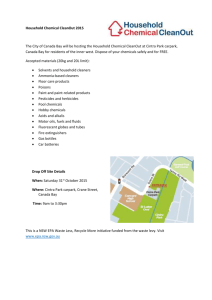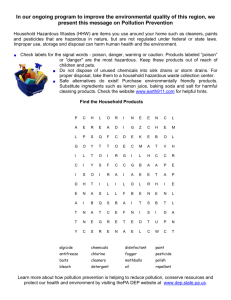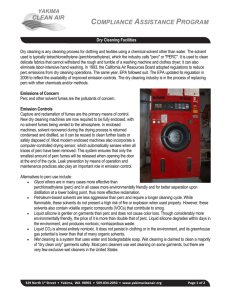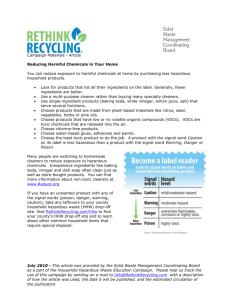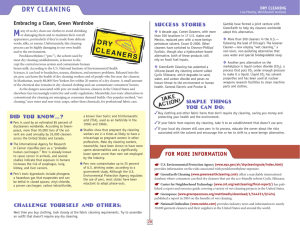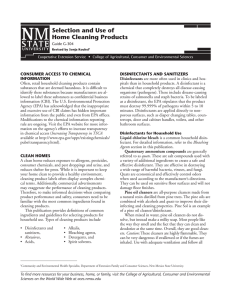2 oz - YourHealthAndMine.Net
advertisement
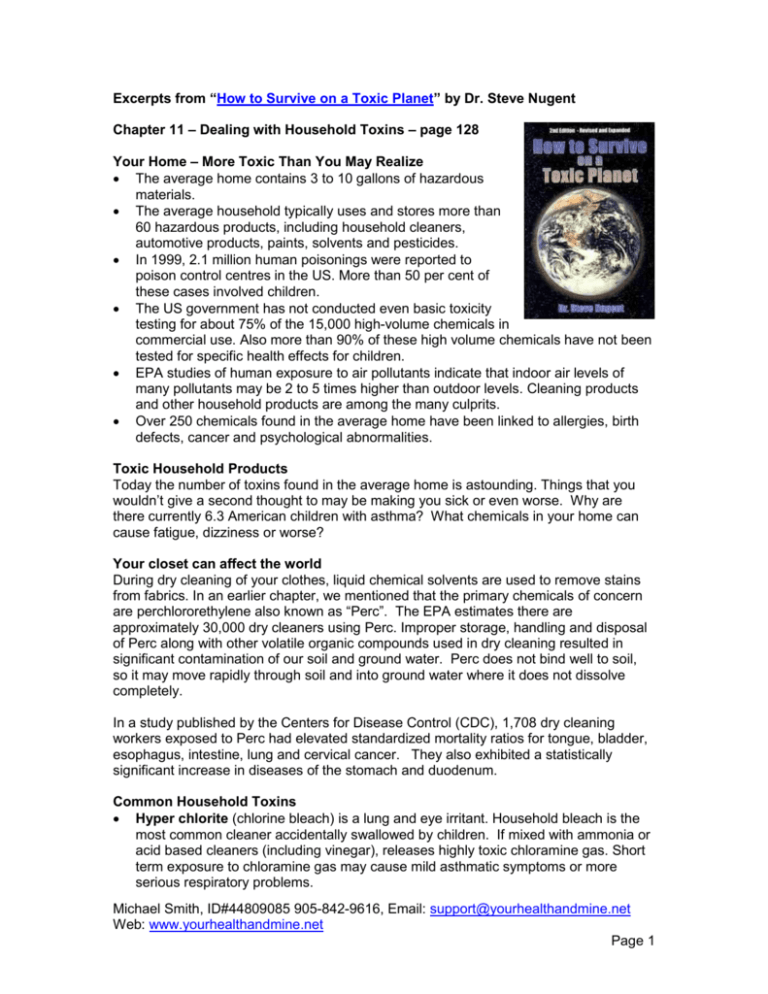
Excerpts from “How to Survive on a Toxic Planet” by Dr. Steve Nugent Chapter 11 – Dealing with Household Toxins – page 128 Your Home – More Toxic Than You May Realize The average home contains 3 to 10 gallons of hazardous materials. The average household typically uses and stores more than 60 hazardous products, including household cleaners, automotive products, paints, solvents and pesticides. In 1999, 2.1 million human poisonings were reported to poison control centres in the US. More than 50 per cent of these cases involved children. The US government has not conducted even basic toxicity testing for about 75% of the 15,000 high-volume chemicals in commercial use. Also more than 90% of these high volume chemicals have not been tested for specific health effects for children. EPA studies of human exposure to air pollutants indicate that indoor air levels of many pollutants may be 2 to 5 times higher than outdoor levels. Cleaning products and other household products are among the many culprits. Over 250 chemicals found in the average home have been linked to allergies, birth defects, cancer and psychological abnormalities. Toxic Household Products Today the number of toxins found in the average home is astounding. Things that you wouldn’t give a second thought to may be making you sick or even worse. Why are there currently 6.3 American children with asthma? What chemicals in your home can cause fatigue, dizziness or worse? Your closet can affect the world During dry cleaning of your clothes, liquid chemical solvents are used to remove stains from fabrics. In an earlier chapter, we mentioned that the primary chemicals of concern are perchlororethylene also known as “Perc”. The EPA estimates there are approximately 30,000 dry cleaners using Perc. Improper storage, handling and disposal of Perc along with other volatile organic compounds used in dry cleaning resulted in significant contamination of our soil and ground water. Perc does not bind well to soil, so it may move rapidly through soil and into ground water where it does not dissolve completely. In a study published by the Centers for Disease Control (CDC), 1,708 dry cleaning workers exposed to Perc had elevated standardized mortality ratios for tongue, bladder, esophagus, intestine, lung and cervical cancer. They also exhibited a statistically significant increase in diseases of the stomach and duodenum. Common Household Toxins Hyper chlorite (chlorine bleach) is a lung and eye irritant. Household bleach is the most common cleaner accidentally swallowed by children. If mixed with ammonia or acid based cleaners (including vinegar), releases highly toxic chloramine gas. Short term exposure to chloramine gas may cause mild asthmatic symptoms or more serious respiratory problems. Michael Smith, ID#44809085 905-842-9616, Email: support@yourhealthandmine.net Web: www.yourhealthandmine.net Page 1 Petroleum distillates (metal polishes). Short term exposure can cause temporary eye clouding. Longer exposure can damage the nervous system, skin, kidneys and eyes. Ammonia (glass cleaner) is a lung and skin irritant. If mixed with chlorine, releases chloramine gas. Short term exposure to chloramine gas may cause coughing, choking and lung damage. Asthmatics may be particularly vulnerable to chloramine gas. Phenol and cresol (disinfectants) are corrosive. They can cause diarrhea, fainting, dizziness and kidney/liver damage. Nitrobenzene (furniture and floor polishes) can cause shallow breathing, vomiting and death. Associated with cancer and birth defects. Formaldehyde (preservative in many household products; used as a glue in particle board and plywood furniture). It is a probable human carcinogen. Perchloroethylene (Perc) is used in dry cleaning solvents, spot removers and carpet cleaners. It is liked to tongue, bladder, esophagus, intestine, lung and cervical cancer. Naphthalene or Para dichlorobenzene (moth balls, toilet bowl cleaners) can irritate eyes, skin and respiratory tract. Chronic exposure to naphthalene can cause damage to the liver, kidneys, skin and central nervous system. Para dichlorobenzene is a probable carcinogen that can also harm the central nervous system, liver and kidneys. High concentration of fumes may irritate eyes, nose, throat and lungs. Hydrochloric acid or sodium acid sulfate (toilet bowl cleaners) can either burn the skin or cause vomiting, diarrhea and stomach burns if swallowed. It can cause blindness if inadvertently splashed in the eyes. Phenol and pentachlorophenol (spray starch). Any aerosolized particle including corn starch may irritate the lungs. Phosphates are minerals that act as water softeners. Although they are very effective cleaners, phosphates also act as fertilizers. When cleaning products go down the drain, phosphates are discharged into our rivers, lakes, estuaries and oceans. In lakes and rivers especially, phosphates cause rapid growth of algae, resulting in pollution of the water. Many states have banned phosphates from household laundry detergents and some other cleaning products. Automatic dish washing detergents are usually exempt from phosphate restrictions and most major brands contain phosphates. Alkyl phenols and their derivatives are found in some laundry detergents, disinfecting cleaners, all-purpose cleaners, spot removers, hair colours and other hair-care products and spermicides. These break down to alkyl phenol ethoxylates which are endocrine (glandular) disrupters. They are slow to biodegrade and have been shown to disrupt the endocrine systems of fish, birds and mammals. Volatile organic compounds are widely used as ingredients in household products. All of these products can release pollutants as you use them and to some degree while in storage. Some of the hazardous volatile organic compounds (VOCs) that frequently pollute indoor air may be emitted from aerosol products, dry cleaned clothing, paints, varnishes, glues, art supplies, cleansers, spot removers, floor waxes, floor polishes and air fresheners. See individual instances below. Trichloroethylene is one of the chemicals suspected of causing a cluster of childhood leukemia cases due to drinking water contamination in the town of Michael Smith, ID#44809085 905-842-9616, Email: support@yourhealthandmine.net Web: www.yourhealthandmine.net Page 2 Woburn, Massachusetts in the early 1980’s. The subsequent lawsuit against the polluting company was the subject of the movie “A Civil Action”. High levels of toluene can out pregnant women at risk of having babies with neurological problems, retarded growth and developmental problems. Xylenes can also cause birth defects. Styrene is a suspected endocrine disrupter – a chemical that can interfere, block or mimic hormones in humans or animals. VOCs such as xylene, ketones and aldehydes are found in many aerosol products and air fresheners. Researchers found that babies less than 6 months old in homes where air fresheners were used on most days had 30 per cent more ear infections than those exposed less than once per week. Dioxins Dioxins are carcinogenic and are never manufactured deliberately but are unintentionally created by heating plastic in your own kitchen or from burning plastic in municipal garbage disposal. You should never cook in plastic containers. Remove food from plastic first and put into glass cookware that is designed for oven, microwave or stove tops. That includes cling wrap and other “microwaveable” plastic wraps. Dioxin pollution is persistent and bioaccumulative which means that it ends up in our food and our bodies. According to the “American People’s Dioxin Report” about 90 to 98 per cent of the general populations exposure to dioxins is through contaminated food primarily animal fat in meat, fish, poultry and dairy products. Chapter 12 – A Close Look at the Air We Breathe – page 145 When it comes to indoor air, most people don’t give it much thought. If they can breathe and they are not in pain or dead, the air must be OK. I have warned repeatedly that how you feel in the 21st century is no longer an accurate gauge of your health. Many people have experienced what seems to be sudden disease without warning. I believe that such problems can brew inside you for years while you are apparently symptom free. Health effects from indoor pollutants, as with many other toxins may be experienced soon after exposure, but more probably, years later. Then it will often be too late. Michael Smith, ID#44809085 905-842-9616, Email: support@yourhealthandmine.net Web: www.yourhealthandmine.net Page 3
